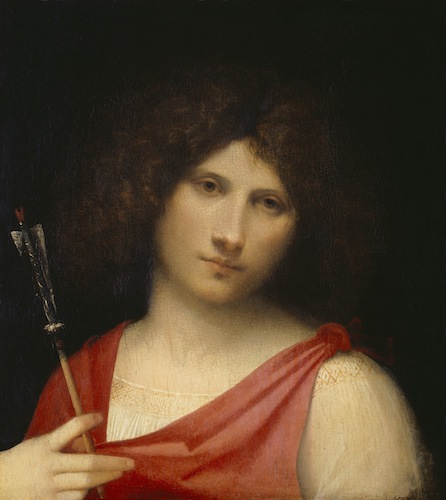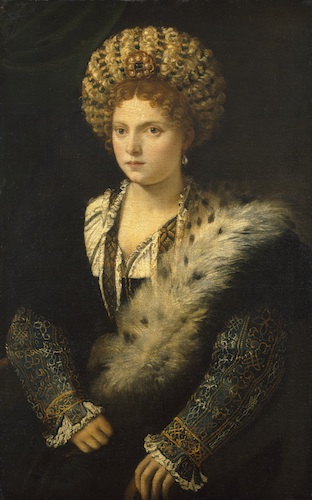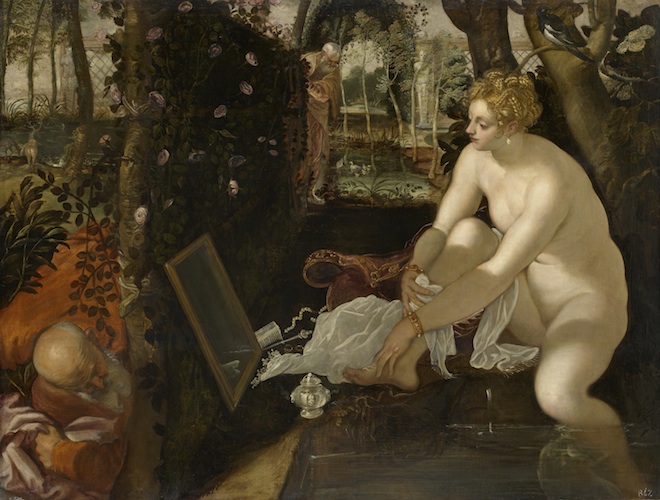Masters Of Venice, At The De Young Museum, San Francisco
In her book The World of Venice, Jan Morris describes an arrival at one of the most artful places in the world. “It is very old, and very grand, and bent-backed… It is a gnarled but gorgeous city… [It] seems to shimmer — with pinkness, with age, with self-satisfaction, with sadness, with delight… The navigator stows away his charts and puts on a gay straw hat; for he has reached that paragon among landfalls, Venice.
“You wouldn’t think of the phrase “bent-backed” or the word “sadness” were you to see the current exhibition at The de Young Museum in San Francisco titled The Masters of Venice. But Jan Morris goes on to memorably describe a city whose glories include the many amazing paintings presented in this show.
These pictures come from the collection of the Gemäldegalerie of Vienna’s Kunsthistorisches Museum. They form of kind of primer to what was being done in the development of new techniques in painting in the 15th and 16th century in Venice, by artists of supreme genius.
Among them are Mantegna, Giorgione, Titian, Tintoretto, Bassano and Veronese. Each is a major figure in the passage of Venetian art of the 1500’s, and the examples of each’s work in this show reaffirm his unique importance to that city and its artistic heritage.
Giorgio da Castelfranco, known as Giorgione, often painted figures with such spectral softness that he is acclaimed for his ability to do so. His portrait Youth with an Arrow (1508 – 1510) shows a dreamy boy perhaps in a contemplation of love that includes the irony of being wounded by that love. It is a painting of extraordinary fame, and when you are standing before it, you yourself can wander into a similar contemplation, eased to it by the great beauty of the boy and the wandering of his thoughts.
Tiziano Vecellio’s Portrait of Isabella d’Este, Marchioness of Mantua (1534 – 1536) is a technical tour de force that exhibits what this great master, who was known as Titian, can do to paint objects that have totally unrelated surfaces and qualities. This beautiful woman wears highly decorated, complicated clothing that features fur, velvet, embroidery, and jewel be-decked silk, all of which are treated with exceptional attention to detail and lively accuracy. You could be forgiven for thinking that she is alive before you, and that she is perhaps a little shy of the pleasure that she is giving you.
There is an edge of comedy in this picture, too. When Isabella sat for this picture, she was apparently a few decades older in fact than the portrait shows her to be. With a smile on her face, I imagine, she wrote that “The portrait by Titian’s hand is of such a pleasing type that we doubt that we were ever, at the age he represents, of such beauty that is contained in it.”
For me, the star of this show is Tintoretto’s Susanna and the Elders(1555 – 1556). One tradition in Venetian art of this period is that of painters providing erotic scenes for private viewing by the purchaser and whoever might be alone with him or her at the moment. This is one such, and it is an amazement. In the biblical book of Daniel, Susanna, a young married woman, is bathing in a fantastic garden. Two old magistrates, crazy for her, come to spy upon her and to take in her lovely nudity. Tintoretto’s painting shows the titillating drama with such mad complexity of surroundings that you feel you will be taken away by the swirling beauty of the garden that frames her. But, like the magistrates, you finally cannot take your eyes off Susanna herself. Her skin and hair and, especially, the piece of sheer white cloth with which she is daubing herself are of startling sensual clarity. Also, she is enjoying the view she has of herself in a mirror, a moment of unguarded vanity. She revels in her own beauty.
This exhibit is accompanied by a very fine catalog that gives the viewer short and informative biographies of each of the painters and reproductions of the paintings themselves..
Also — and importantly — the catalog tells of the major changes in painting technique that took place in Venice during this time. Just to name three: the shift from painting on wood panels to painting on canvas, a change that is written about in a fascinating essay by Elke Oberthaler. (You wouldn’t think that a highly technical description of different weaves of canvas and the effect that those differences have on how paint can be applied could be so fascinating. I assure you that, in this essay, it is.); the development of oil painting and the important transition it provided from painting with egg tempura; and the new practice by artists of changing the image directly on the canvas, rather than contemplating all the images beforehand in preparatory drawings.
By Terence Clarke
Source: www.huffingtonpost.com


